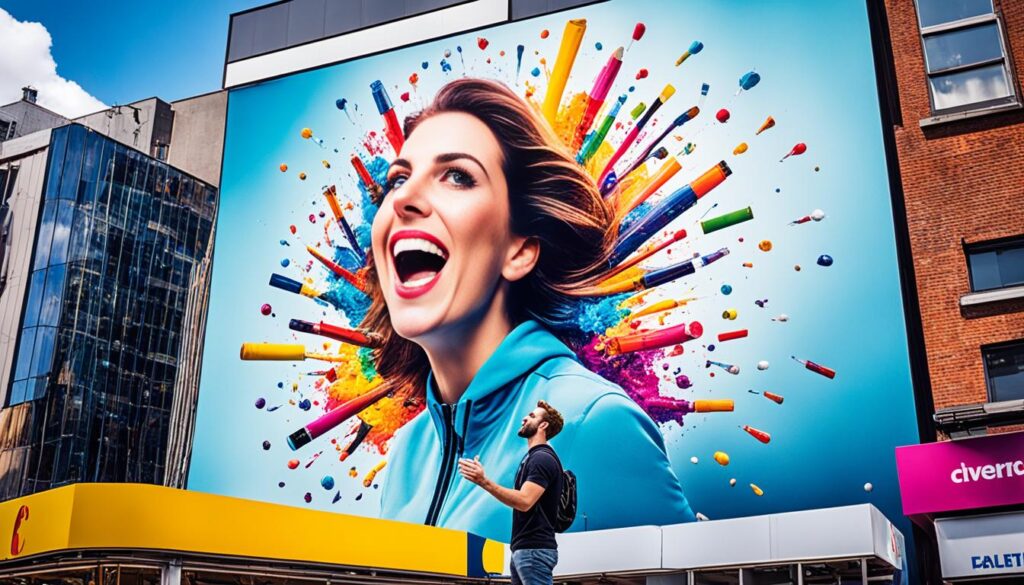Welcome to our blog post delving into the undeniable connection between creative thinking and achieving sales success in the world of marketing. In today’s competitive landscape, marketers are constantly seeking new ways to captivate their target audiences and secure their loyalty. However, it’s important to recognize that true creativity extends beyond creating visually appealing campaigns or memorable slogans – it ultimately revolves around producing tangible results, particularly in terms of increasing sales.
Throughout this article, we will explore why a marketing campaign’s ability to sell should be the ultimate measure of its creative success. We will uncover the importance of creativity in marketing, examine how it impacts advertising effectiveness, and reveal the insights shared by advertising legend David Ogilvy. Additionally, we will provide practical strategies for effectively using creativity in your marketing efforts and discuss the key elements that define truly creative advertising.
Prepare to be inspired as we delve into the fascinating realm where creativity meets sales success. Together, let’s unlock the potential of creative marketing to drive your business forward.
Key Takeaways:
- Creativity in marketing should be measured by its ability to drive sales.
- The impact of creativity on advertising effectiveness is significant.
- David Ogilvy emphasized that if a marketing campaign doesn’t sell, it isn’t truly creative.
- A creative advertisement effectively communicates the message of the product or service.
- Having a clear goal is essential in creating a truly creative ad.
What Is the Importance of Creativity in Marketing?
In the world of marketing, creativity plays a pivotal role in capturing the attention and engagement of consumers. Creativity is the spark that ignites innovation and sets brands apart from their competitors. It is the driving force behind memorable and impactful campaigns that resonate with audiences.
How does creativity impact advertising effectiveness?
Creativity has a direct impact on the effectiveness of advertising. A creative and compelling ad captures the viewer’s attention, evokes emotions, and creates a lasting impression. It has the power to make a brand memorable and drive consumer action. With creative advertising, brands can stand out from the clutter and deliver their message in a unique and memorable way.
What did David Ogilvy say about creativity in advertising?
David Ogilvy, a renowned advertising executive, famously said, “If it doesn’t sell, it isn’t creative.” He believed that creativity should always serve the purpose of driving sales. Ogilvy emphasized the importance of aligning creativity with the ultimate goal of advertising: to deliver results and generate revenue. According to him, true creativity lies in the ability to create compelling campaigns that effectively sell products or services.
How can creativity enhance a marketing campaign’s performance?
Creativity has the power to enhance a marketing campaign’s performance in various ways. It can captivate an audience, increase brand awareness, build brand loyalty, and drive customer engagement. Creative campaigns stand out and leave a lasting impression on consumers, helping brands to foster strong relationships and drive business growth. Additionally, creative strategies can generate word-of-mouth marketing and organic social media buzz, amplifying a campaign’s reach and impact.
Does creativity play a role in digital marketing?
Absolutely! Creativity is equally important in digital marketing. With the rapid advancements in technology and the rise of social media, brands have endless opportunities to engage with their target audience online. Creative digital marketing campaigns leverage the unique capabilities of digital platforms to captivate, entertain, and provide value to consumers. Whether it’s through innovative content, interactive experiences, or immersive storytelling, creativity in digital marketing drives engagement, fosters brand loyalty, and ultimately boosts business results.
How to effectively use creativity in marketing?
In order to harness the power of creativity in marketing, it is essential to understand the key elements of a successful and impactful advertising campaign. By aligning the creative message with the brand, marketers can create a cohesive and memorable experience for their target audience. But how can we ensure that the creative message resonates with the audience and leads to a compelling marketing headline? Moreover, how can creativity be leveraged in email and performance marketing to drive optimal results? Let’s explore these questions further.
Key elements of a creative advertising campaign
A creative advertising campaign is built on several key elements that contribute to its success:
- Target audience research: Understanding the needs, preferences, and demographics of the target audience is crucial for crafting a campaign that resonates with them.
- Innovative ideas: Creativity thrives on fresh and innovative ideas that capture attention and stand out from the competition.
- Compelling storytelling: A well-crafted story can evoke emotions and create a connection between the brand and the audience.
- Visual appeal: Eye-catching designs and visuals play a significant role in attracting and retaining audience attention.
- Consistent branding: Maintaining consistency in brand messaging and visual identity helps build trust and recognition.
- Measurable goals: Setting clear and measurable goals ensures that the campaign’s success can be accurately evaluated.
Aligning the creative message with the brand
In order to effectively use creativity in marketing, it is crucial for the creative message to align with the brand’s values, personality, and positioning. This alignment ensures that the campaign accurately represents the brand and resonates with the target audience. By staying true to the brand identity, marketers can build trust, credibility, and long-term relationships with their customers.
Strategies to make the creative message resonate with the audience
Resonating with the audience requires a deep understanding of their needs, desires, and pain points. Incorporating the following strategies can help make the creative message highly relevant and relatable:
- Research and analyze audience insights: Conduct thorough research to gain insights into the target audience’s motivations, interests, and behaviors.
- Create personalized experiences: Tailor the creative message to address specific audience segments, ensuring that it speaks directly to their unique needs.
- Evoke emotions: Connect with the audience on an emotional level by triggering emotions that align with the campaign’s objectives and the brand’s essence.
- Use storytelling techniques: Craft narratives that engage the audience, draw them into the brand’s world, and leave a lasting impression.
The role of creativity in developing a compelling marketing headline
A compelling marketing headline is essential for grabbing attention and enticing the audience to explore further. Creativity plays a vital role in developing headlines that are catchy, memorable, and impactful. By using clever wordplay, intriguing questions, or thought-provoking statements, marketers can spark curiosity and make their headlines stand out from the competition.
Leveraging creativity in email and performance marketing
Creativity is not limited to traditional advertising channels but can be effectively leveraged in email and performance marketing as well. In email marketing, creative copywriting and engaging visuals can increase open rates and encourage click-throughs. In performance marketing, creative campaigns that experiment with different formats, targeting options, and ad placements can drive better conversion rates and overall campaign performance.
By effectively using creativity in marketing, marketers can elevate their campaigns, engage their audience on a deeper level, and achieve outstanding results. The following table summarizes the key strategies discussed above:
| Key Elements of a Creative Advertising Campaign | Aligning the Creative Message with the Brand | Strategies to Make the Creative Message Resonate with the Audience | The Role of Creativity in Developing a Compelling Marketing Headline | Leveraging Creativity in Email and Performance Marketing |
|---|---|---|---|---|
| Target audience research | Understanding the brand’s values and personality | Research and analyze audience insights | Using clever wordplay, intriguing questions, or thought-provoking statements | Creative copywriting and engaging visuals in emails |
| Innovative ideas | Maintaining consistency in brand messaging | Create personalized experiences | Crafting unique and memorable phrases that capture attention | Experimenting with different formats, targeting options, and ad placements |
| Compelling storytelling | Evoke emotions | Use storytelling techniques | Incorporating narrative elements that connect with audiences | Using narratives and case studies to demonstrate value |
| Visual appeal | Use storytelling techniques | Employing visual metaphors and imagery | Utilizing striking visuals or typography to draw attention | Designing visually attractive and attention-grabbing email layouts |
| Consistent branding | Reinforce brand identity | Regularly feature brand elements | Highlighting brand’s unique selling proposition (USP) | Ensuring brand visuals and language are uniform across all platforms |
| Measurable goals | Aligning campaign objectives with brand goals | Setting clear, quantifiable targets | Emphasizing the benefit or outcome in the headline | Tracking and analyzing performance to refine strategies |

What defines truly creative advertising?
In the world of advertising, creativity is the key to capturing the attention of consumers and making a lasting impact. Truly creative advertising campaigns go beyond the ordinary and push the boundaries of innovation and imagination. But what exactly defines truly creative advertising?
How can creativity be emphasized in an advertising campaign?
Emphasizing creativity in an advertising campaign involves thinking outside the box and exploring unique ways to engage with the target audience. From captivating visuals to compelling storytelling techniques, creative advertising campaigns are designed to stand out and create a memorable experience for the viewers.
What did David Ogilvy mean by “if it doesn’t sell, it isn’t creative”?
David Ogilvy, a renowned advertising executive, meant that the primary goal of advertising is to sell products or services. No matter how creative an advertisement may be, if it fails to drive sales or deliver results, it cannot be considered truly creative. Creativity should always be in service of achieving the marketing objectives and generating tangible results.
What are the characteristics of a truly creative advertisement?
A truly creative advertisement possesses several characteristics that set it apart from the rest. These include:
- Originality and uniqueness
- An emotional connection with the audience
- Captivating visuals or storytelling
- A clear and memorable message
- Innovative use of technology or media
How does a creative advertisement communicate the message of the product or service effectively?
A creative advertisement effectively communicates the message of a product or service through engaging storytelling, powerful visuals, and clear messaging. By using creativity as a tool, advertisers can capture the attention of the audience, create an emotional connection, and effectively convey the benefits and value of the product or service being advertised.
Why is it important to have a clear goal in mind when creating a truly creative ad?
Having a clear goal is crucial when creating a truly creative ad because it keeps the focus on delivering a message that aligns with the overall marketing objectives. A clear goal helps guide the creative process, ensuring that the advertisement effectively communicates the desired message and drives the desired actions from the target audience. Without a clear goal, creativity alone is not enough to create a successful advertising campaign.

Conclusion
In conclusion, creativity is an essential factor in successful marketing. Throughout this article, we have explored the importance of creativity in driving sales success and its impact on advertising effectiveness. We have discussed the perspective of renowned marketer David Ogilvy, who emphasized that true creativity lies in generating results.
We have also provided insights into effectively using creativity in marketing, including the key elements of a creative advertising campaign and strategies for aligning the creative message with the brand. Additionally, we have explored how creativity can be leveraged to resonate with the target audience, develop compelling marketing headlines, and enhance email and performance marketing.
A truly creative advertisement not only captivates but also effectively communicates the message of the product or service. It aligns with the brand’s values and objectives, compelling the target audience to take action. By having a clear goal in mind during the creative process, marketers can ensure that their campaigns are both innovative and effective.
In summary, embracing creativity in marketing is the key to achieving outstanding results. By prioritizing sales and considering the needs of the target audience, marketers can create campaigns that not only capture attention but also drive conversions. Remember, if a marketing campaign doesn’t sell, it cannot be considered truly creative.
FAQ
How does creativity impact advertising effectiveness?
Creativity plays a significant role in enhancing the effectiveness of advertising. Creative ads have the power to capture attention, evoke emotions, and leave a lasting impression on consumers. They can make a brand memorable and differentiate it from competitors.
What did David Ogilvy say about creativity in advertising?
David Ogilvy, often referred to as the “father of advertising,” famously said, “If it doesn’t sell, it isn’t creative.” According to Ogilvy, true creativity in advertising should always have the goal of selling in mind. Creative ideas and concepts should align with the target audience and effectively communicate the benefits of the product or service.
How can creativity enhance a marketing campaign’s performance?
Creativity can enhance the performance of a marketing campaign by grabbing the audience’s attention and creating a memorable brand experience. It can drive engagement, increase brand recall, and generate positive word-of-mouth. Creative campaigns that resonate with the target audience have the potential to boost sales and achieve a higher return on investment (ROI).
Does creativity play a role in digital marketing?
Absolutely. In the realm of digital marketing, creativity is crucial for cutting through the noise and capturing the online audience’s attention. Creative digital campaigns leverage modern tools and techniques to engage and persuade consumers. Whether it’s eye-catching visuals, interactive content, or compelling copywriting, creativity can make a significant difference in the success of digital marketing efforts.
What are the key elements of a creative advertising campaign?
A creative advertising campaign typically incorporates several key elements, including a compelling message, visually appealing design, strategic placement, and effective targeting. The message should resonate with the target audience and clearly communicate the unique selling points of the product or service. The design should be visually appealing and aligned with the brand’s identity.
How can a marketer ensure that the creative message aligns with the brand?
To ensure alignment between the creative message and the brand, marketers should conduct thorough market research and understand the brand’s core values and target audience. They should create messaging that reflects the brand’s personality and resonates with its target customers. Additionally, consistent branding elements, such as language, visuals, and tone of voice, should be incorporated into the creative message.
What strategies can be employed to make the creative message resonate with the audience?
Understanding the target audience is essential for creating a creative message that resonates. Marketers can employ strategies such as conducting consumer research, identifying pain points and desires, and crafting messaging that directly addresses those points. Emotional appeal, storytelling, and personalization are also effective strategies for making the creative message resonate with the audience.
What role does creativity play in developing a compelling marketing headline?
Creativity plays a crucial role in developing a compelling marketing headline. A creative headline grabs attention, piques curiosity, and entices the audience to read further. It should be concise, impactful, and aligned with the overall message of the marketing campaign. A well-crafted headline can draw the target audience into the content and increase the chances of conversion.
How can creativity be leveraged in email and performance marketing?
In email marketing, creativity can be leveraged by creating visually appealing and engaging email designs, crafting personalized and persuasive copywriting, and incorporating interactive elements. In performance marketing, creativity can be applied to optimize ad formats, messaging, and targeting strategies to drive higher conversion rates and improve overall campaign performance. Creative thinking can help marketers stand out in crowded inboxes and make their messages more compelling.
How can creativity be emphasized in an advertising campaign?
Creativity can be emphasized in an advertising campaign by thinking outside the box, taking risks, and exploring different concepts and ideas. Marketers should strive to create unique and memorable experiences for their audience through clever and innovative storytelling, visuals, and messaging. It’s important to strike the right balance between creativity and effectiveness, ensuring that the creative ideas align with the overall goals of the campaign.
What did David Ogilvy mean by “if it doesn’t sell, it isn’t creative”?
David Ogilvy’s quote emphasizes the importance of sales-driven creativity in advertising. He believed that creativity should always serve the purpose of selling a product or service. A truly creative advertisement takes into account the target audience, their needs and desires, and effectively communicates the value proposition. If an advertisement fails to drive sales, regardless of how creative or clever it may seem, it ultimately falls short of achieving its purpose.
What are the characteristics of a truly creative advertisement?
A truly creative advertisement is one that effectively communicates the message of a product or service while capturing the attention and interest of the target audience. It combines unique and innovative concepts, visuals, and storytelling techniques to create a memorable brand experience. A creative advertisement should be aligned with the brand’s identity, evoke emotion, and persuade consumers to take action.
Why is it important to have a clear goal in mind when creating a truly creative ad?
Having a clear goal is crucial when creating a truly creative ad because it ensures that the creative elements are purposeful and effective. A clear goal helps focus the creative process, align the content with the target audience’s needs and desires, and guide the strategic decisions that will ultimately drive sales. Without a clear goal, creativity may result in a visually appealing but ultimately ineffective advertisement.










